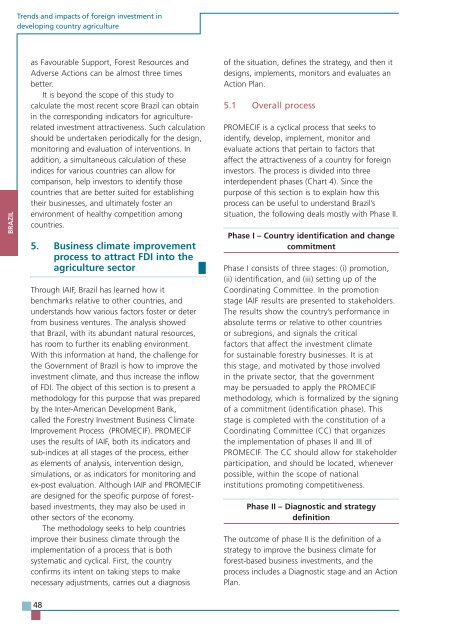TRENDS AND IMPACTS OF FOREIGN INVESTMENT IN DEVELOPING COUNTRY AGRICULTURE
TRENDS AND IMPACTS OF FOREIGN INVESTMENT IN DEVELOPING COUNTRY AGRICULTURE
TRENDS AND IMPACTS OF FOREIGN INVESTMENT IN DEVELOPING COUNTRY AGRICULTURE
Create successful ePaper yourself
Turn your PDF publications into a flip-book with our unique Google optimized e-Paper software.
BRAZIL<br />
Trends and impacts of foreign investment in<br />
developing country agriculture<br />
as Favourable Support, Forest Resources and<br />
Adverse Actions can be almost three times<br />
better.<br />
It is beyond the scope of this study to<br />
calculate the most recent score Brazil can obtain<br />
in the corresponding indicators for agriculturerelated<br />
investment attractiveness. Such calculation<br />
should be undertaken periodically for the design,<br />
monitoring and evaluation of interventions. In<br />
addition, a simultaneous calculation of these<br />
indices for various countries can allow for<br />
comparison, help investors to identify those<br />
countries that are better suited for establishing<br />
their businesses, and ultimately foster an<br />
environment of healthy competition among<br />
countries.<br />
5. Business climate improvement<br />
process to attract FDI into the<br />
agriculture sector <br />
Through IAIF, Brazil has learned how it<br />
benchmarks relative to other countries, and<br />
understands how various factors foster or deter<br />
from business ventures. The analysis showed<br />
that Brazil, with its abundant natural resources,<br />
has room to further its enabling environment.<br />
With this information at hand, the challenge for<br />
the Government of Brazil is how to improve the<br />
investment climate, and thus increase the inflow<br />
of FDI. The object of this section is to present a<br />
methodology for this purpose that was prepared<br />
by the Inter-American Development Bank,<br />
called the Forestry Investment Business Climate<br />
Improvement Process (PROMECIF). PROMECIF<br />
uses the results of IAIF, both its indicators and<br />
sub-indices at all stages of the process, either<br />
as elements of analysis, intervention design,<br />
simulations, or as indicators for monitoring and<br />
ex-post evaluation. Although IAIF and PROMECIF<br />
are designed for the specific purpose of forestbased<br />
investments, they may also be used in<br />
other sectors of the economy.<br />
The methodology seeks to help countries<br />
improve their business climate through the<br />
implementation of a process that is both<br />
systematic and cyclical. First, the country<br />
confirms its intent on taking steps to make<br />
necessary adjustments, carries out a diagnosis<br />
48<br />
of the situation, defines the strategy, and then it<br />
designs, implements, monitors and evaluates an<br />
Action Plan.<br />
5.1 Overall process<br />
PROMECIF is a cyclical process that seeks to<br />
identify, develop, implement, monitor and<br />
evaluate actions that pertain to factors that<br />
affect the attractiveness of a country for foreign<br />
investors. The process is divided into three<br />
interdependent phases (Chart 4). Since the<br />
purpose of this section is to explain how this<br />
process can be useful to understand Brazil’s<br />
situation, the following deals mostly with Phase II.<br />
Phase I – Country identification and change<br />
commitment<br />
Phase I consists of three stages: (i) promotion,<br />
(ii) identification, and (iii) setting up of the<br />
Coordinating Committee. In the promotion<br />
stage IAIF results are presented to stakeholders.<br />
The results show the country’s performance in<br />
absolute terms or relative to other countries<br />
or subregions, and signals the critical<br />
factors that affect the investment climate<br />
for sustainable forestry businesses. It is at<br />
this stage, and motivated by those involved<br />
in the private sector, that the government<br />
may be persuaded to apply the PROMECIF<br />
methodology, which is formalized by the signing<br />
of a commitment (identification phase). This<br />
stage is completed with the constitution of a<br />
Coordinating Committee (CC) that organizes<br />
the implementation of phases II and III of<br />
PROMECIF. The CC should allow for stakeholder<br />
participation, and should be located, whenever<br />
possible, within the scope of national<br />
institutions promoting competitiveness.<br />
Phase II – Diagnostic and strategy<br />
definition<br />
The outcome of phase II is the definition of a<br />
strategy to improve the business climate for<br />
forest-based business investments, and the<br />
process includes a Diagnostic stage and an Action<br />
Plan.


